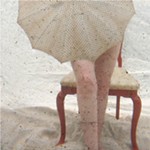Extra-Ordinary: The Everyday Object in American Art
AMOA's shows rejoice over blurred lines between interested corporate marketing and disinterested beauty
Reviewed by Nikki Moore, Fri., Sept. 14, 2007

Extra-Ordinary: The Everyday Object in American Art/Everyday Objects: Extra-Ordinary Austin Designs
Austin Museum of Art – Downtown, through Nov. 4
Who gets to call it art?
I imagine most of us have had those moments, shopping at HEB, when a box, a can, a shampoo bottle stands out as something other than an object for consumption. It might be the color on the label, the pleasing uniformity of repetition on any given shelf, but there are times when everyday objects go beyond their everyday impact. We can call this great design, superior marketing, or capitalism at its most refined. Or we can call it complicity, all the while smiling as we happily run that item down the little conveyer belt to the checkout. "Extra-Ordinary: The Everyday Object in American Art," Austin Museum of Art's current exhibition in collaboration with the Whitney Museum of American Art, rejoices over these blurred lines between interested corporate marketing and disinterested beauty. All the iconic figures of American culture (and American pop art) line up to have their say: French fries and ketchup make their appearance near Campbell's soup and a stack of Brillo boxes, while soda bottles, painted yarn, and some laminate sculpture share in AMOA's limelight. But why is this called art?
To answer just such a question, AMOA has dedicated a small room to the showing of Who Gets to Call It Art?, an 80-minute film by the former New York Metropolitan Museum's own Henry Geldzahler. Whether you sit through the entire thing or just a few minutes, this star-studded film has a lot of answers to give for such a fundamental art question and is a great introduction to American pop art and its implications. Ultimately, however, a show like "Extra-Ordinary" has more to do with asking questions than answering them, and with the addition of Austin's own designs and designers in the exhibition titled "Everyday Objects: Extra-Ordinary Austin Designs," we find ourselves back in the shopping aisles, wondering where we will next be so happily co-opted. The "L-Broom" by Design Edge is certainly elegant enough to be wall art, and the TurboChef 30-inch Double Wall Speedcook Oven, featured in countless interior-design magazines this month, is not only aesthetically pleasing, it is charming, inventive, and terrifically pragmatic (apart from the unsung sticker price, of course) in a way we might call "beautiful." In this beauty, though, the tension that was the topic of 1960s pop art, what gave those pieces their weight in the midst of their familiarity and iconoclasm, comes back into question. Who gets to call it art? Is it art because it is the everyday transformed into something lovely? Or is it art because it questions the very appeal and seduction of everyday objects and helps us to see our own contributions to capitalist consumption? I'd like to think it is a bit of both ... but given my love for packaging, design, and a great tomato-soup label, I'm not sure I can be trusted.










